Abstract
1. Single intravenous doses (25, 50 and 100 micrograms) of medetomidine (MPV-785, an imidazole derivative), a selective alpha 2-adrenoceptor agonist, were administered to eight healthy male volunteers in a double-blind, placebo-controlled study. 2. The following dose-related effects, all of which were compatible with an agonistic action of the drug at alpha 2-adrenoceptors, were noted: reductions of systolic and diastolic blood pressure (maximum 18/11 mm Hg), heart rate (maximum 10 beats min-1), saliva secretion (maximum 84%) and noradrenaline levels in plasma (maximum 70%). 3. Dose-dependent sedation or impairment of vigilance was also observed, both by subjective and objective (critical flicker fusion threshold) assessments, with the highest dose actually inducing sleep in five of the subjects. 4. The observed effects were in general agreement with those previously seen after intravenous administration of the centrally acting antihypertensive alpha 2-adrenoceptor activating drug, clonidine, but of a shorter duration. 5. The relative importance of alpha 2-adrenoceptors located in peripheral tissues and in the central nervous system for the drug's cardiovascular effects could not be determined, but the high lipid solubility of the compound and the rapid onset of sedation are in favour of a major central component. 6. Medetomidine may be a useful tool for the investigation of the physiology and pharmacology of alpha 2-adrenoceptors in man. In addition, the therapeutic and diagnostic uses of the compound should be investigated in pathological conditions related to increased sympathetic neuronal activity.
Full text
PDF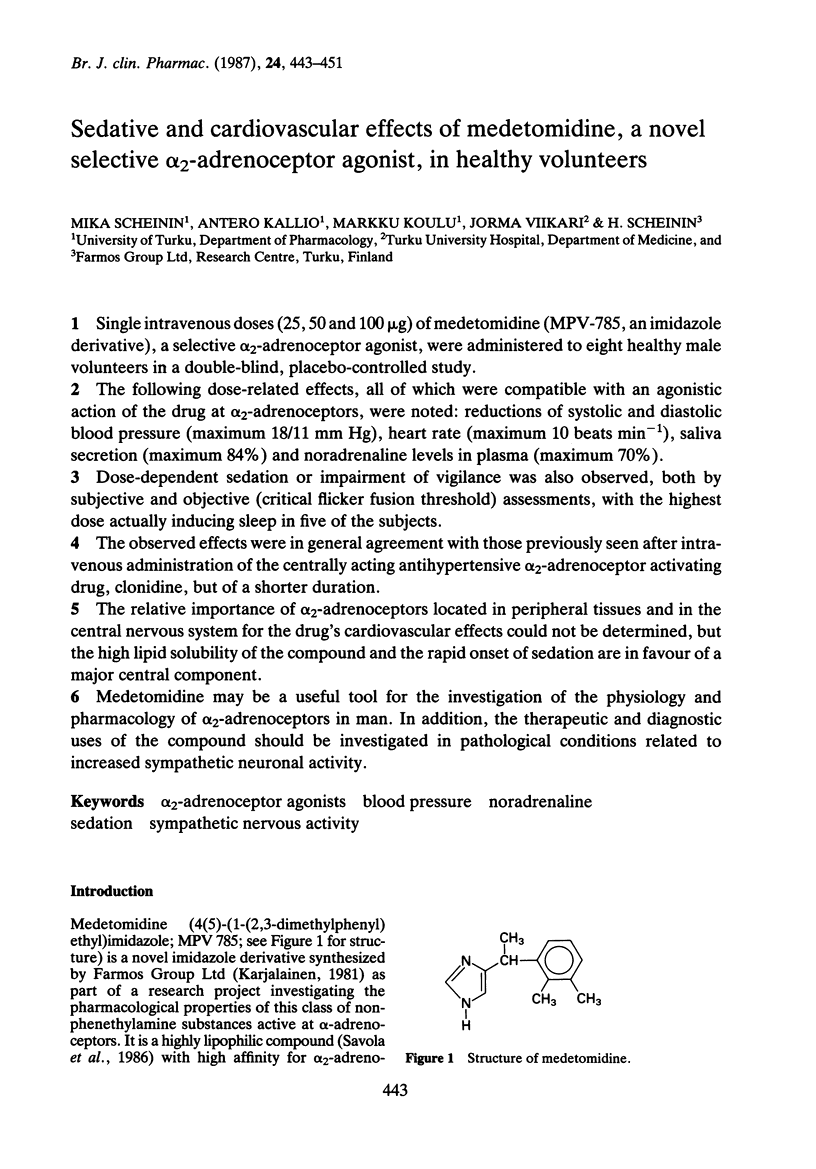
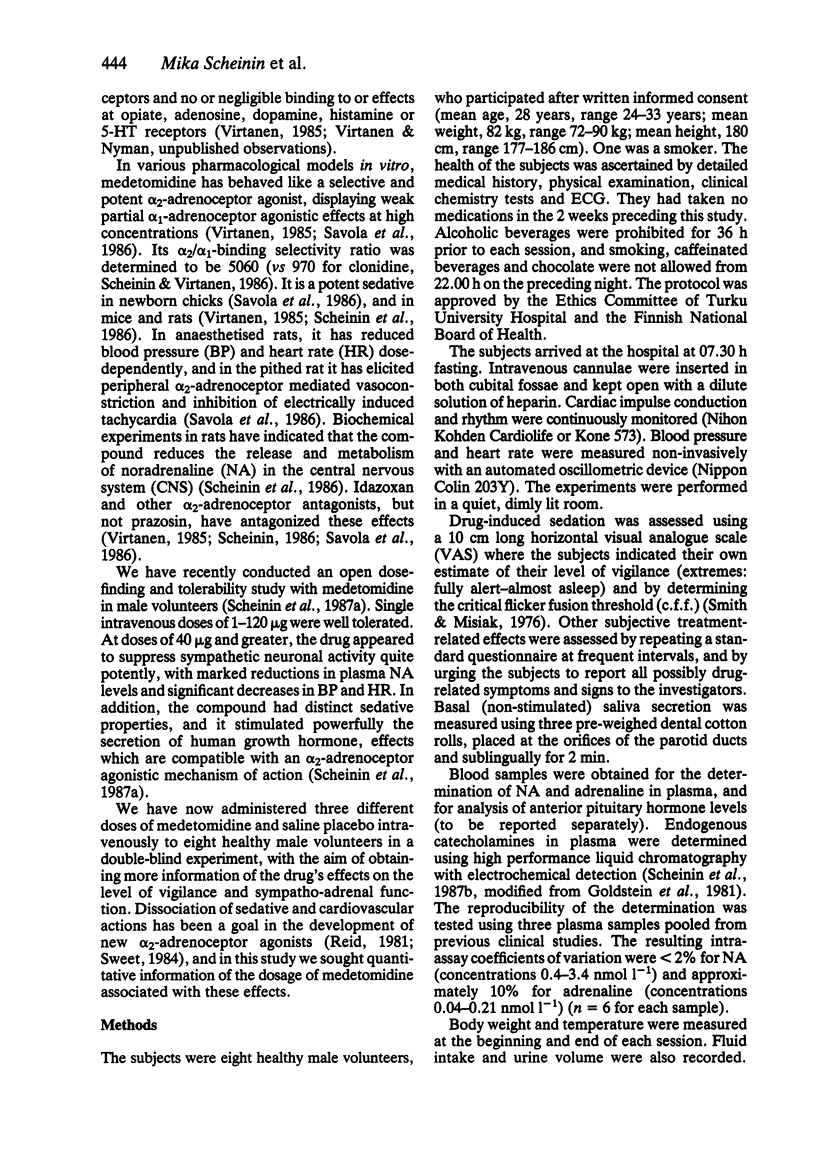
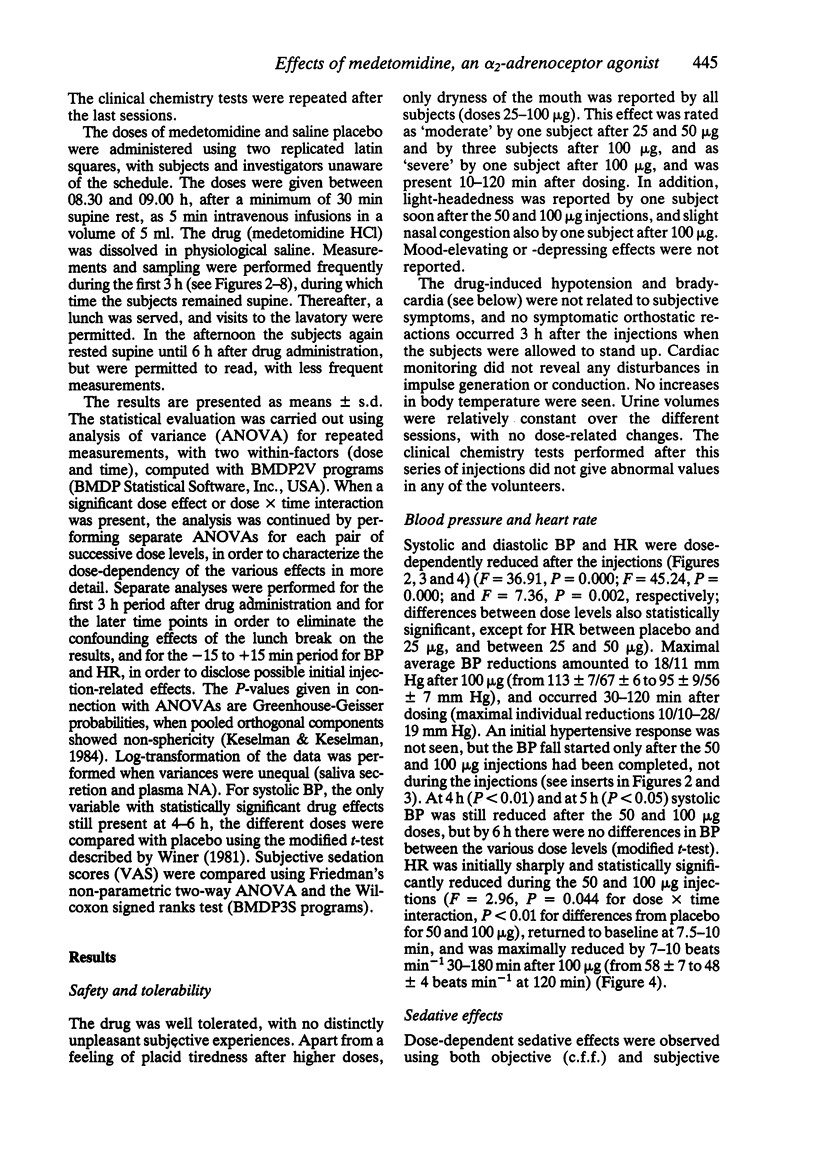

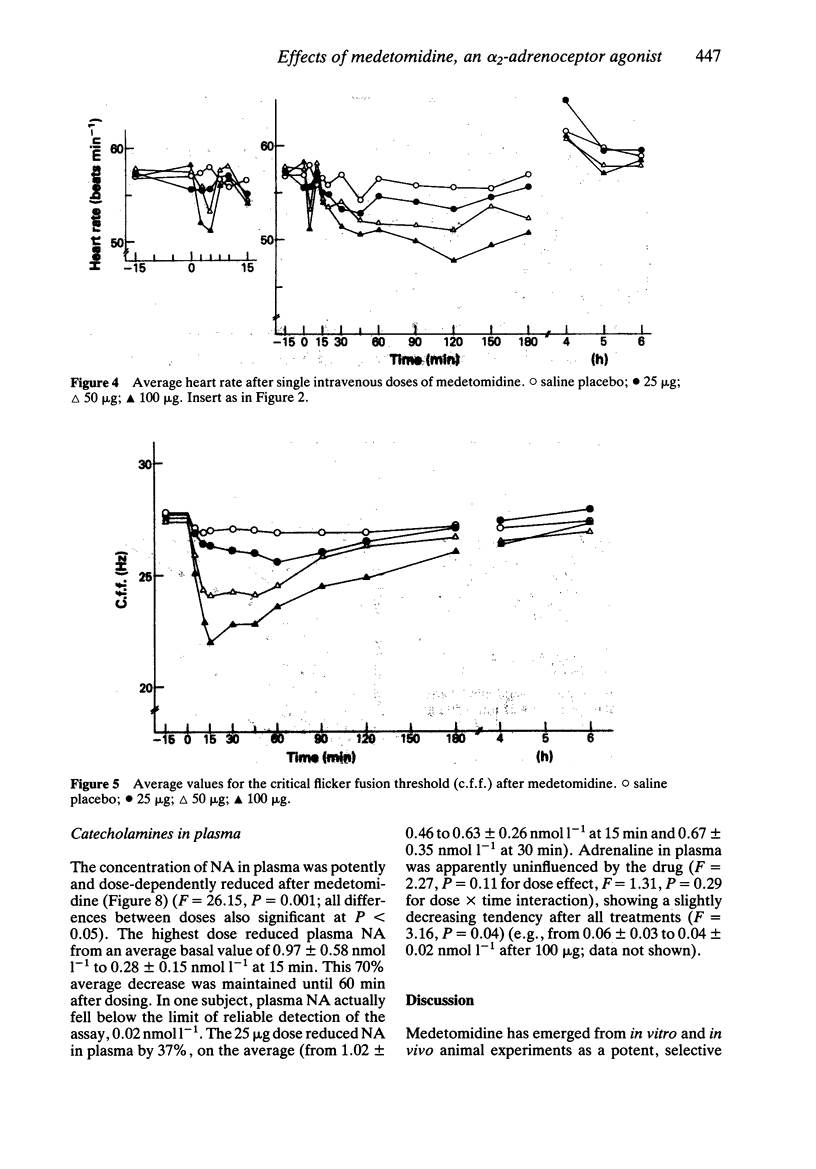
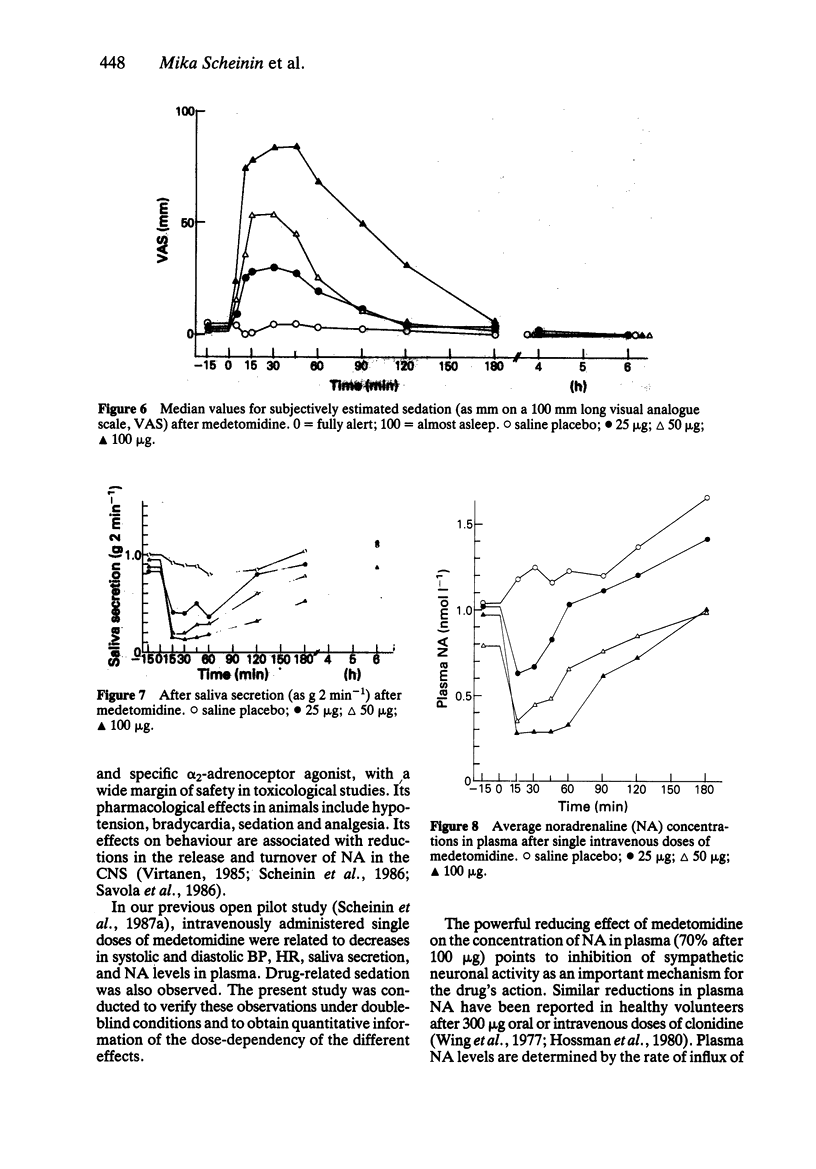
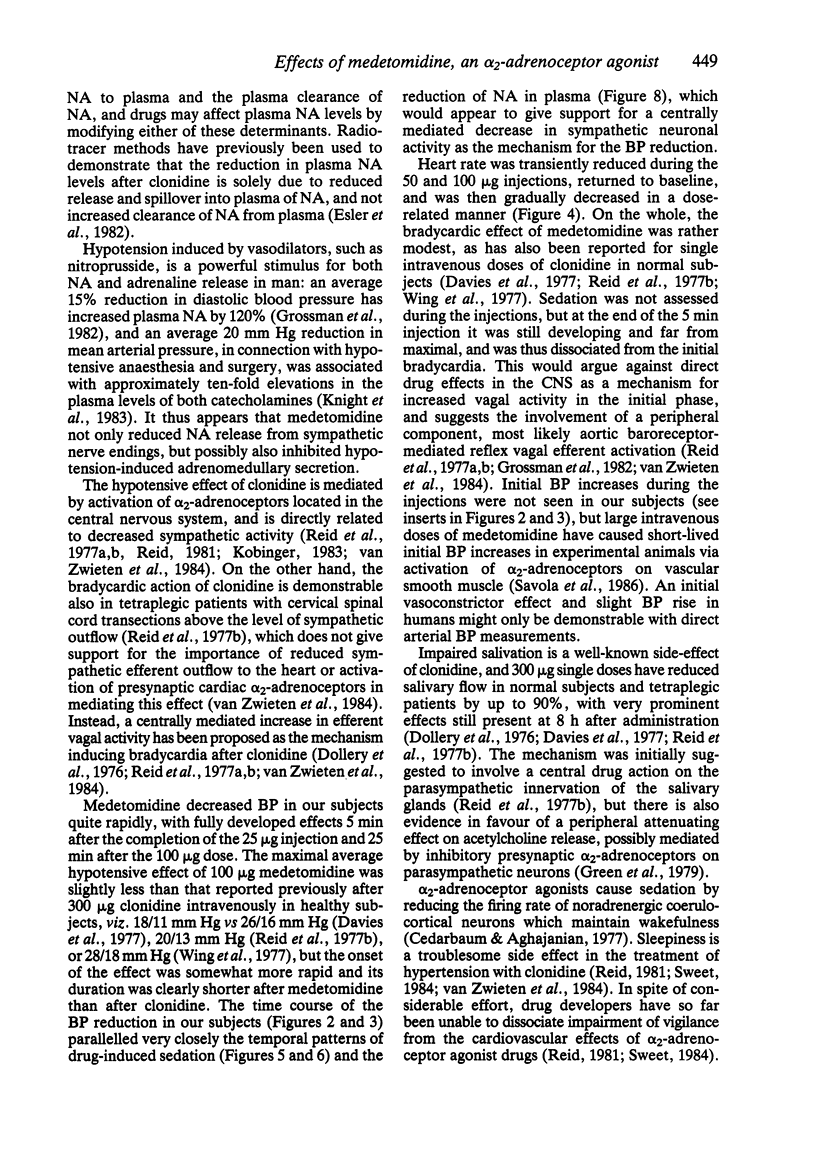

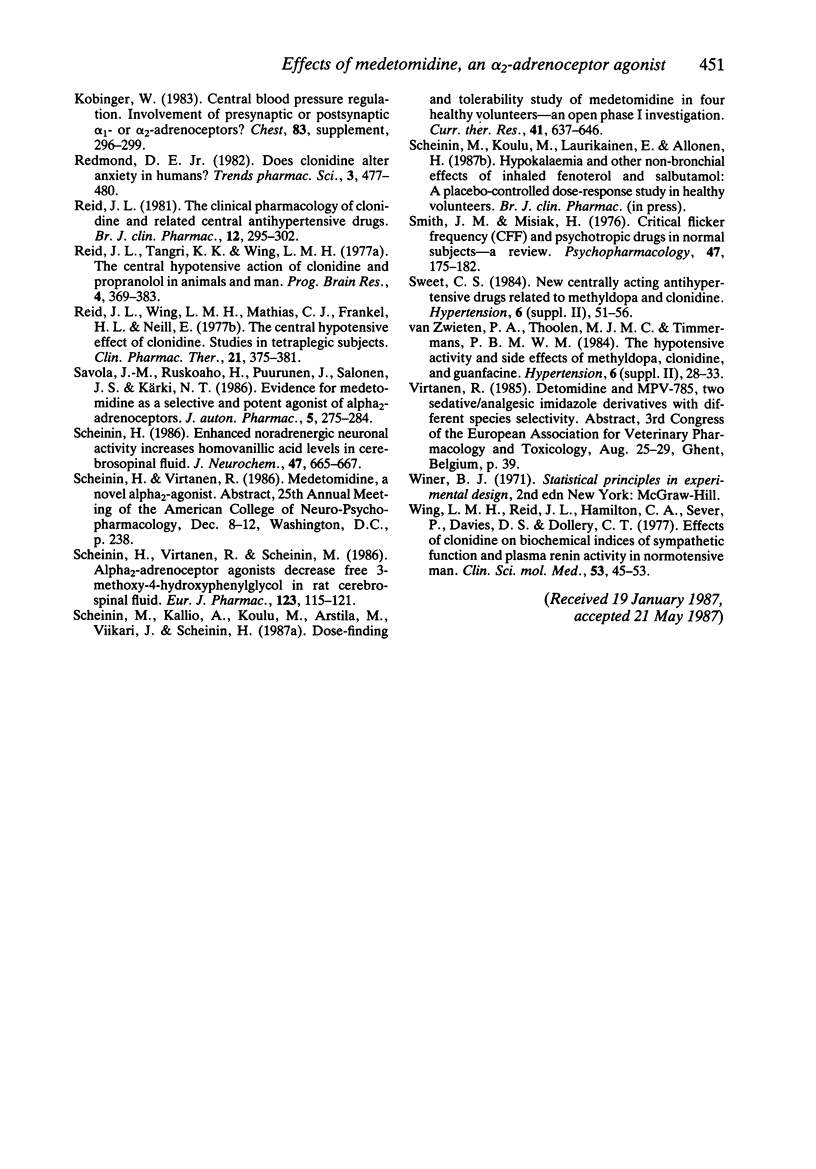
Selected References
These references are in PubMed. This may not be the complete list of references from this article.
- Cedarbaum J. M., Aghajanian G. K. Catecholamine receptors on locus coeruleus neurons: pharmacological characterization. Eur J Pharmacol. 1977 Aug 15;44(4):375–385. doi: 10.1016/0014-2999(77)90312-0. [DOI] [PubMed] [Google Scholar]
- Davies D. S., Wing A. M., Reid J. L., Neill D. M., Tippett P., Dollery C. T. Pharmacokinetics and concentration-effect relationships of intervenous and oral clonidine. Clin Pharmacol Ther. 1977 May;21(5):593–601. doi: 10.1002/cpt1977215593. [DOI] [PubMed] [Google Scholar]
- Dollery C. T., Davies D. S., Draffan G. H., Dargie H. J., Dean C. R., Reid J. L., Clare R. A., Murray S. Clinical pharmacology and pharmacokinetics of clonidine. Clin Pharmacol Ther. 1976 Jan;19(1):11–17. doi: 10.1002/cpt197619111. [DOI] [PubMed] [Google Scholar]
- Esler M., Leonard P., O'Dea K., Jackman G., Jennings G., Korner P. Biochemical quantification of sympathetic nervous activity in humans using radiotracer methodology: fallibility of plasma noradrenaline measurements. J Cardiovasc Pharmacol. 1982;4 (Suppl 1):S152–S157. doi: 10.1097/00005344-198200041-00030. [DOI] [PubMed] [Google Scholar]
- Glassman A. H., Jackson W. K., Walsh B. T., Roose S. P., Rosenfeld B. Cigarette craving, smoking withdrawal, and clonidine. Science. 1984 Nov 16;226(4676):864–866. doi: 10.1126/science.6387913. [DOI] [PubMed] [Google Scholar]
- Gold M. S., Redmond D. E., Jr, Kleber H. D. Clonidine blocks acute opiate-withdrawal symptoms. Lancet. 1978 Sep 16;2(8090):599–602. doi: 10.1016/s0140-6736(78)92823-4. [DOI] [PubMed] [Google Scholar]
- Goldstein D. S., Feuerstein G., Izzo J. L., Jr, Kopin I. J., Keiser H. R. Validity and reliability of liquid chromatography with electrochemical detection for measuring plasma levels of norepinephrine and epinephrine in man. Life Sci. 1981 Feb 2;28(5):467–475. doi: 10.1016/0024-3205(81)90139-9. [DOI] [PubMed] [Google Scholar]
- Green G. J., Wilson H., Yates M. S. The effect of clonidine on centrally and peripherally evoked submaxillary salivation. Eur J Pharmacol. 1979 Jan 15;53(3):297–300. doi: 10.1016/0014-2999(79)90136-5. [DOI] [PubMed] [Google Scholar]
- Grossman S. H., Davis D., Gunnells J. C., Shand D. G. Plasma norepinephrine in the evaluation of baroreceptor function in humans. Hypertension. 1982 Jul-Aug;4(4):566–571. doi: 10.1161/01.hyp.4.4.566. [DOI] [PubMed] [Google Scholar]
- Hossmann V., Maling T. J., Hamilton C. A., Reid J. L., Dollery C. T. Sedative and cardiovascular effects of clonidine and nitrazepam. Clin Pharmacol Ther. 1980 Aug;28(2):167–176. doi: 10.1038/clpt.1980.146. [DOI] [PubMed] [Google Scholar]
- Keselman H. J., Keselman J. C. The analysis of repeated measures designs in medical research. Stat Med. 1984 Apr-Jun;3(2):185–195. doi: 10.1002/sim.4780030211. [DOI] [PubMed] [Google Scholar]
- Knight P. R., Lane G. A., Hensinger R. N., Bolles R. S., Bjoraker D. G. Catecholamine and renin--angiotensin response during hypotensive anesthesia induced by sodium nitroprusside or trimethaphan camsylate. Anesthesiology. 1983 Sep;59(3):248–253. [PubMed] [Google Scholar]
- Kobinger W. Central blood pressure regulation. Involvement of presynaptic or postsynaptic, alpha 1- or alpha 2-adrenoceptors? Chest. 1983 Feb;83(2 Suppl):296–299. [PubMed] [Google Scholar]
- Reid J. L., Tangri K. K., Wing L. M. The central hypotensive action of clonidine and propranolol in animals and man. Prog Brain Res. 1977;47:369–383. doi: 10.1016/S0079-6123(08)62740-5. [DOI] [PubMed] [Google Scholar]
- Reid J. L. The Fourth Lilly Prize Lecture, University of Aberdeen, September 1980. The clinical pharmacology of clonidine and related central antihypertensive agents. Br J Clin Pharmacol. 1981 Sep;12(3):295–302. doi: 10.1111/j.1365-2125.1981.tb01217.x. [DOI] [PMC free article] [PubMed] [Google Scholar]
- Reid J. L., Wing L. M., Mathias C. J., Frankel H. L., Neill E. The central hypotensive effect of clonidine. Studies in tetraplegic subjects. Clin Pharmacol Ther. 1977 Apr;21(4):375–381. doi: 10.1002/cpt1977214375. [DOI] [PubMed] [Google Scholar]
- Savola J. M., Ruskoaho H., Puurunen J., Salonen J. S., Kärki N. T. Evidence for medetomidine as a selective and potent agonist at alpha 2-adrenoreceptors. J Auton Pharmacol. 1986 Dec;6(4):275–284. doi: 10.1111/j.1474-8673.1986.tb00654.x. [DOI] [PubMed] [Google Scholar]
- Scheinin H. Enhanced noradrenergic neuronal activity increases homovanillic acid levels in cerebrospinal fluid. J Neurochem. 1986 Sep;47(3):665–667. doi: 10.1111/j.1471-4159.1986.tb00662.x. [DOI] [PubMed] [Google Scholar]
- Scheinin H., Virtanen R., Scheinin M. alpha 2-Adrenoceptor agonists decrease free 3-methoxy-4-hydroxyphenylglycol in rat cerebrospinal fluid. Eur J Pharmacol. 1986 Apr 9;123(1):115–121. doi: 10.1016/0014-2999(86)90695-3. [DOI] [PubMed] [Google Scholar]
- Smith J. M., Misiak H. Critical flicker frequency (CFF) and psychotropic drugs in normal human subjects-a review. Psychopharmacologia. 1976 May 28;47(2):175–182. doi: 10.1007/BF00735818. [DOI] [PubMed] [Google Scholar]
- Wing L. M., Reid J. L., Hamilton C. A., Sever P., Davies D. S., Dollery C. T. Effects of clonidine on biochemical indices of sympathetic function and plasma renin activity in normotensive man. Clin Sci Mol Med. 1977 Jul;53(1):45–53. doi: 10.1042/cs0530045. [DOI] [PubMed] [Google Scholar]


